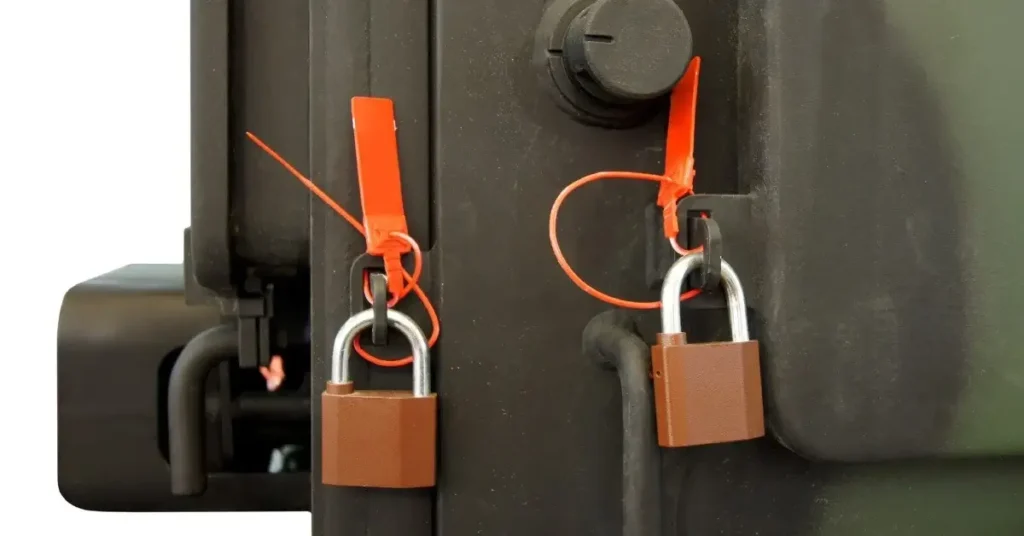How to security seals protect businesses and consumers

Security is a top priority for businesses across industries. From protecting assets to ensuring customer trust, companies rely on various measures to keep their products and services safe. One of the most effective yet often overlooked security measures is the use of security seals.
Security seals play a crucial role in preventing theft, tampering, and counterfeiting. These simple yet highly effective devices help safeguard goods during transport, storage, and distribution. More than just a deterrent, they provide visible evidence of unauthorized access, ensuring that businesses and consumers can identify potential threats before they cause harm.
But how exactly do security seals work, and why are they so important? Let’s dive deeper into their function, benefits, and the industries that rely on them.
What Are Security Seals?
Definition and Purpose
Security seals are tamper-evident devices used to protect goods, containers, and packaging from unauthorized access. They serve as both a deterrent and an alert system—if a seal is broken or altered, it indicates possible tampering.
Different Types of Security Seals
Security seals come in various forms, each designed for specific applications:
- Tamper-evident seals: Show visible signs of tampering if removed or broken.
- Indicative seals: Lightweight seals used mainly for tracking purposes.
- Barrier seals: Heavy-duty seals that require tools to remove.
- Electronic seals: Smart seals that provide real-time monitoring.
Common Industries Using Security Seals
Many industries depend on security seals, including:
- Logistics and transportation – Ensuring goods remain intact during shipping.
- Pharmaceuticals – Protecting medications from contamination.
- Food industry – Preventing food fraud and ensuring safety.
- Banking – Securing cash and sensitive documents.
Types of Security Seals and Their Functions
Tamper-Evident Seals
These seals change appearance when tampered with, such as leaving a “VOID” message or breaking into pieces. They are widely used in pharmaceuticals and food packaging.
Indicative Seals
These lightweight seals are mainly used for tracking rather than providing strong security. They help companies monitor the movement of goods.
Barrier Seals
Made of durable materials like metal or high-strength plastic, these seals require cutting tools for removal. They are commonly used on shipping containers and high-value shipments.
Electronic Seals
Smart seals integrate GPS, RFID, or Bluetooth technology to provide real-time data on goods’ location and condition. These are becoming increasingly popular in modern supply chains.
How Security Seals Protect Businesses
Security seals are essential in business operations for several reasons:
Preventing Theft and Tampering
Unauthorized access to shipments or storage can lead to theft. Security seals deter potential criminals and provide proof if tampering occurs.
Ensuring Product Authenticity and Quality
Counterfeit products are a major problem, especially in pharmaceuticals and electronics. Security seals help verify product authenticity and protect brand reputation.
Enhancing Supply Chain Security
Supply chains involve multiple checkpoints. Security seals ensure that goods remain intact from manufacturer to consumer.
Compliance with Regulations and Industry Standards
Many industries require security seals to comply with legal and safety regulations, ensuring businesses meet necessary standards.
How Security Seals Protect Consumers
Security seals are not just beneficial for businesses—they also protect consumers in several ways:
Preventing Counterfeit Products
Fake goods can be harmful or ineffective. Security seals provide a way for consumers to verify authenticity before making a purchase.
Ensuring Product Safety
Tampered food, medicine, or cosmetics can pose health risks. Security seals prevent contamination and ensure safety.
Building Consumer Trust and Brand Credibility
A visible security seal reassures customers that the product has not been altered, increasing trust in the brand.

Security Seals in Different Industries
Security seals are used across multiple industries to protect assets, ensure compliance, and build consumer trust. Here’s how different sectors rely on these seals for security and integrity:
Logistics and Transportation
The logistics industry deals with transporting goods across vast distances, often involving multiple handling points. Security seals ensure that shipments remain untouched and free from tampering.
- Preventing cargo theft: Shipping containers and trucks use high-strength barrier seals to deter theft.
- Tracking and verification: RFID-enabled seals help track goods in real time.
- Regulatory compliance: Many customs agencies require security seals on international shipments.
Pharmaceuticals and Healthcare
Counterfeit or tampered medicines can pose serious health risks. Security seals ensure that medical products are safe and untampered.
- Tamper-evident packaging: Seals on medicine bottles, vials, and boxes indicate if they have been opened.
- Authentication: Unique serial numbers on seals help verify product authenticity.
- Compliance with health regulations: Government agencies require secure packaging for pharmaceuticals.
Food and Beverage Industry
Food safety is a critical concern for consumers and businesses alike. Security seals help prevent contamination and food fraud.
- Tamper-proof packaging: Seals on food containers, bottles, and jars prevent unauthorized opening.
- Quality assurance: Companies use seals to maintain hygiene standards.
- Protecting against counterfeiting: Fake food products are a growing issue, and security seals help consumers identify genuine brands.
Banking and Cash Handling
Banks and financial institutions use security seals to protect cash, confidential documents, and valuable assets.
- Cash-in-transit protection: Sealed bags ensure that money remains untouched during transport.
- Document security: Confidential paperwork is sealed to prevent unauthorized access.
- ATM security: Security seals on ATM cash cassettes prevent tampering.
Features of an Effective Security Seal
Not all security seals are created equal. The effectiveness of a seal depends on several key features:
Tamper Resistance and Evidence Visibility
A good security seal should clearly show signs of tampering, whether through breakage, color changes, or “VOID” messages.
Unique Serialization and Tracking
- Numbered seals: Prevent duplication and allow tracking.
- Barcodes and RFID chips: Provide digital tracking and authentication.
Durability and Reliability
- Weather-resistant materials: Prevent damage from heat, cold, or moisture.
- Strong adhesion or locking mechanisms: Ensure the seal stays intact until removed.
Technological Advancements in Security Seals
The security industry is evolving, and so are security seals. Here are some cutting-edge innovations:
Smart Security Seals
- Electronic tracking: Some seals come with digital sensors to detect tampering.
- Mobile integration: Apps allow businesses to scan and verify seals in real-time.
RFID-Enabled Seals
- Automated tracking: Radio-frequency identification (RFID) seals make inventory management easier.
- Remote monitoring: Businesses can track shipments without opening them.
Blockchain Integration for Tracking
Blockchain technology is revolutionizing security by creating unchangeable records of seal verification. This ensures complete transparency in the supply chain.
Best Practices for Using Security Seals
Using security seals correctly is crucial to maximizing their effectiveness. Here’s how businesses can ensure proper usage:
Proper Application and Handling
- Ensure a secure fit: A loose seal can be easily removed and replaced.
- Use the right type: Different goods require different levels of security.
Employee Training and Awareness
- Educate staff: Employees should recognize tampered seals.
- Standard operating procedures: Businesses should implement clear guidelines for seal usage.
Regular Audits and Quality Checks
- Routine inspections: Regularly check for damaged or missing seals.
- Report issues: Immediately investigate any security breaches.
Challenges and Limitations of Security Seals
While security seals provide excellent protection, they are not foolproof. Here are some common challenges:
Potential Vulnerabilities
- Skilled tampering: Some criminals can manipulate seals without visible damage.
- Fake seals: Counterfeit security seals can be used to disguise tampering.
Cost Considerations
- High-tech seals: Advanced security features come at a higher cost.
- Budget constraints: Smaller businesses may struggle with expenses.
The Need for a Multi-Layered Security Approach
Security seals work best when combined with other security measures, such as surveillance, alarms, and authentication systems.
Future of Security Seals in Business Protection
As security threats evolve, so do the measures used to counter them. The future of security seals looks promising with these advancements:
Innovations in Seal Technology
- Biometric seals: Fingerprint-activated seals could provide ultimate security.
- DNA markers: Some seals use unique DNA-based ink to prevent duplication.
Integration with AI and IoT
- AI-powered detection: Smart systems can analyze tampering attempts.
- IoT-connected seals: Businesses can monitor security seals remotely.
Predicted Trends in Security Measures
- Eco-friendly seals: More companies are adopting biodegradable security seals.
- Global standardization: Governments and industries are working toward universal security seal regulations.
Conclusion
Security seals are an essential tool in protecting businesses and consumers from theft, tampering, and counterfeiting. By providing a clear indication of unauthorized access, these seals help maintain the integrity of products and services.
From logistics and pharmaceuticals to food safety and banking, security seals play a vital role in ensuring compliance, preventing fraud, and building consumer trust. As technology continues to advance, businesses must stay updated with the latest security solutions to safeguard their assets effectively.
By investing in high-quality security seals and following best practices, companies can significantly reduce risks and enhance their overall security strategy.




